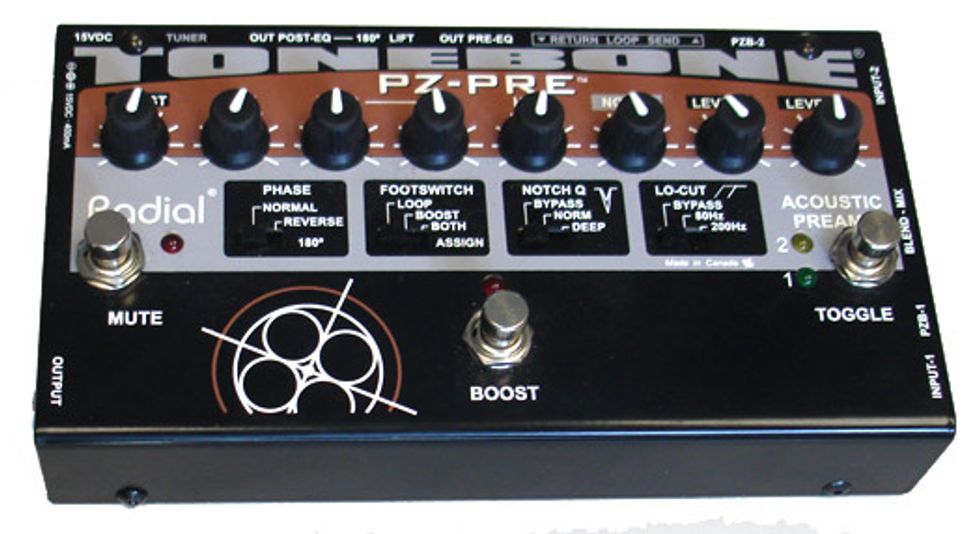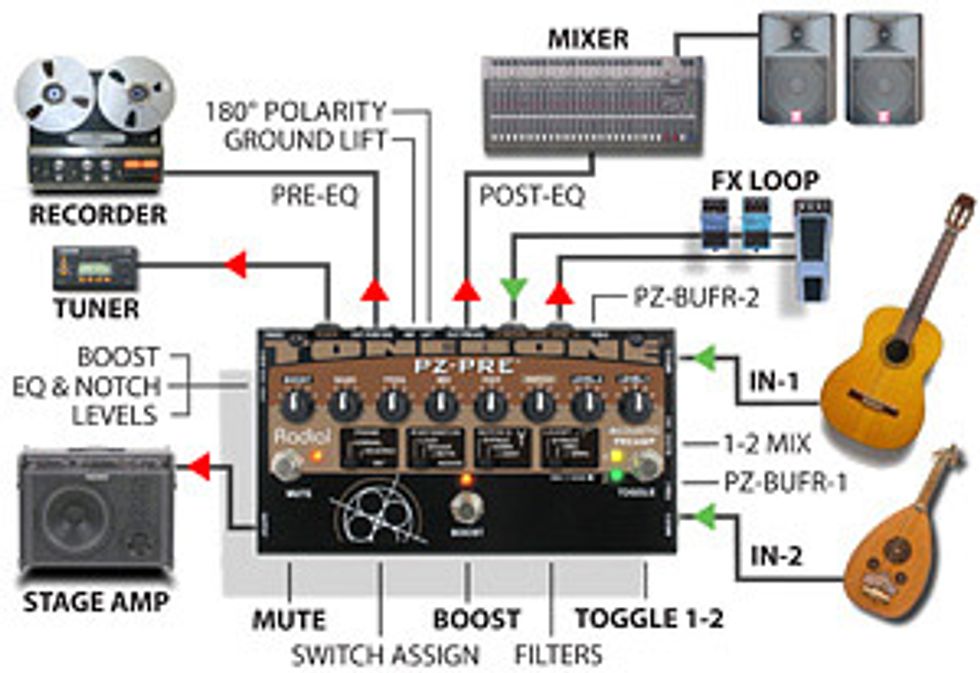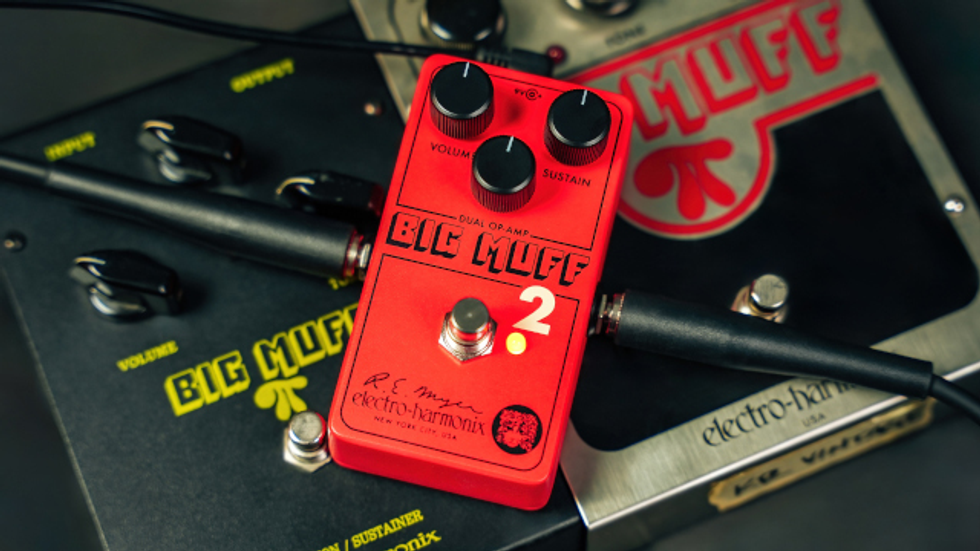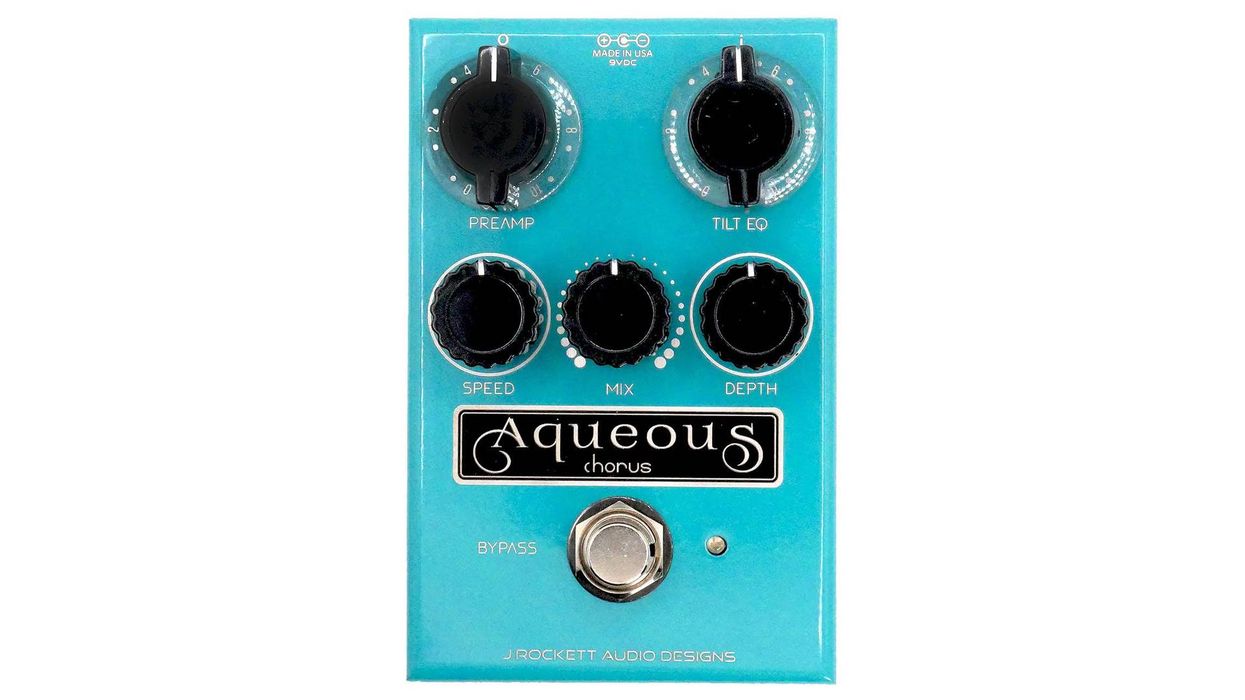Not long ago, the person behind the counter at your local music store would’ve laughed had you told them you were looking for a DI, a preamp, a booster, a feedback-buster, an A/B-Y and an EQ in a single unit, let alone in a stompbox. As it turns it out, that product actually exists; and get this... it actually has more features.

I had no idea anyone even had the stones to climb that engineering mountain before Radial Engineering president Peter Janis told me about the PZ-Pre late last year. I had told him about my acoustic/electric AB problem – I couldn’t find a decent DI switcher that would allow me to go from an acoustic to an electric without killing one sound or the other – so he sent me a prototype of the PZ-Pre, warning me that it would do more than I expected. He was right.
Problem Solver
I had been looking for something that, as far as I knew, no one made. I switch between a Martin and a Tele when I play out, but hate lugging multiple rigs to a show. I also hate switching cables mid-set. I needed something to act as Grand Central Station for the two instruments, my stage amp, the FOH signal, my Tele effects and maybe even the monitor mix. Heck, I was greedy enough to hope it would have some tone controls. The PZ-Pre had it all and much more, including acoustic-savvy tone controls.
Think of the PZ-Pre as an acoustic-minded AB-Y on steroids. The two inputs have recessed switches that activate Class-A piezo buffers (10 meg Ohm), opening up all kinds of possibilities for using different acoustic instruments. Even further, there is a recessed switch that allows you to blend both inputs, which is ideal for instruments with two pickups and two outs. Each input has an independent gain control so evening out levels is easy. For pure switching between the two, there’s a stomp toggle with an indicator light for each input.
Features
|
The PZ-Pre has a lot to take in at first glace, so perhaps it will help to think of it as having four kinds of signal adjustments: an EQ, an array of feedback/hum solutions, a boost and an effects loop.
I found the 3-band EQ with the semi-parametric mid to be very rich, with only slight nudges being necessary to round out my Martin DCX1E (with flat onboard EQ’ing). The extra mid was particularly handy, allowing me to dial in the guitar’s sweet spot with ease. When testing it with a Taylor 615ce, I was actually able to use the extra mid to achieve two very different tones within its much larger sweet spot. They both had character and were useful for coloring the sound in different ways – I totally wasn’t expecting that.
Feedback/hum solutions are all over the PZ-Pre. First, there’s the high pass filter (80Hz, 200Hz) which allowed me to cut annoying low moans on one occasion. There’s also a Notch Q switch with a dedicated pot, which I had never really used before; I am now a big fan. I learned how to quickly sweep through the normal and deep V settings to cut the midrange feedback I used to rely on a sound hole cover to eliminate. The PZ-Pre also comes with two signal polarity reverse switches for battling nodal lines that tend to intersect right where you want to stand on stage; one is in the main 1/4” output and the other is assigned to the Post-EQ/Post-Effects mic-level XLR direct out. There is also a Pre-EQ/Pre-Effects mic-level XLR direct out and a recessed switch that lifts the ground pin for both of them.
The easiest toggle to find is the Boost switch (12 dB variable), which is front and center for a reason. That assignable switch can control the boost, the effects loop or both.
As you can see, this preamp/AB-Y/DI/EQ/etc. – let’s just call it a pedal – will accommodate different players in different ways. Logistically, it’s the perfect problem solver and then some for my acoustic/Tele situation. I set the EQ for my acoustic and use the effects loop for my Tele’s effects. Switching guitars is as simple as literally switching guitars on my body, stomping on the input selector toggle and then stomping on the boost/effects loop (I set to both) if I need it.
The unit itself is just a bit wider than three Boss pedals side-by-side, but not as long or deep as a single one (8”w x 4.25”d x 2”h). The metal casing is tougher than nails (14 gauge steel) and will no doubt handle the rigors of gig bag travel and stage stomping for a very long time. The pedal runs off an included 15DVC power supply.
Knocks
When a company puts a lot of features into a product, it inevitably invites a higher level of criticism that may or may not be justified. Having so much going on simply increases the functionality, the price and the expectations. Some people think $400 retail/$300 street is a lot of money for a preamp/DI/EQ, but in this case I don’t, considering everything this jewel does. However, it is hard not to develop steep expectations when you’re dealing with something so surprisingly versatile.
For example, although the EQ is great, there is no way to store separate settings for each input. I got around this by using a different EQ pedal in the effects loop with specific settings for my second input.
Having two lights to indicate which input is activated is a great idea. I''m always in favor of being able to see what''s going on with just a quick glance, especially on a dark stage. Unfortunately, the red/green lights are just millimeters apart and are of the shades that slightly colorblind people like me can''t distinguish. Of course, to expect a manufacturer to cater to so many little nuances starts to get ridiculous, depending on your point of view.
Likewise, the preamp sounded pretty darn good to my ears and was a nice fit for the electronic systems in the Martin and Taylor acoustics I used with it, but rarely do five people in a room agree on the quality of a preamp. As for my wacky idea of using it with a Tele, the signal was ever so slightly dull, but sounded just fine when I added some external boost and sparkle control in the effects loop. As with any preamp, don’t expect 1073 quality without paying for it, and understand that your particular guitar and pickups always have the chance of not being a good fit for a particular preamp design.
Final Verdict
I’d say this product delivered above and beyond the call of my somewhat unrealistic expectations, and I’ve barely tapped into it. I can foresee utilizing the recessed blend switch to have both inputs hot in order to facilitate an unexpected sit-in-on-the fly situation. I see this pedal being a cool tool for streamlined re-amp experimentation live or in the studio. This product also gave me the itch to get a hollowbody with a two output piezo system. Clearly, this pedal does more than anything else in its class. I don’t know what’s more exciting, the problems it solves or the possibilities it opens. In the spirit of AB-Y design, I guess you could say the answer is either or both.
Buy if...
you need a multi-tasking DI
Skip if...
you demand EQs for each input
Rating...
Retail $400 - Radical Engineering - tonebone.com |










![Rig Rundown: Russian Circles’ Mike Sullivan [2025]](https://www.premierguitar.com/media-library/youtube.jpg?id=62303631&width=1245&height=700&quality=70&coordinates=0%2C0%2C0%2C0)










